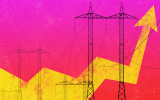
More marine life may end up on the threatened species list as the unprecedented algal bloom along much of South Australia’s coastline kills thousands of sea creatures.
Tens of thousands of marine animals have been killed since the algal bloom was identified off the Fleurieu Peninsula in March.
It has since spread along more of the state’s coastline.
The federal government has expedited an expert assessment of the impact of the toxic algal bloom to better understand its impact on marine life.
Already, more than 400 species of marine life, including sharks, rays and fish, have washed up on SA beaches.
The assessment will determine if any additional species need to be added to the threatened list, which already includes whitefin swellshark, longnose skate, greeneye spurdog, grey skate, and coastal stingaree.
Adding more species are added to the list may trigger the development of conservation plans.
It is a similar process to the assessment after the 2019-20 Black Summer bushfires, when the south-eastern glossy black cockatoo and mountain skink were added to Australia’s threatened species list.
“We can leave no stone unturned to understand the impact of this on local marine life, so we can begin investing in the appropriate strategies to bring these important animals back to healthy numbers,” Environment Minister Murray Watt said on Wednesday.
On Monday, Watt apologised to South Australians who feel the federal response to the bloom has been too slow.
The Albanese government hopes a recently announced jointly funded $28 million package will be enough to fix the damage.
The package is expected to support affected businesses, undertake more research and clean up the beaches where thousands of dead marine animals have washed up.
Watt was in Adelaide on Wednesday to meet affected businesses, industry and the community and Opposition Leader Sussan Ley touring affected areas.
Ley said the government’s response to the algal bloom had been “woefully inadequate” and urged it to act ahead of Prime Minister Anthony Albanese visiting SA in coming days.
“This is a natural disaster and it is a national disaster,” she said.
“Actually deliver the support now if you know it’s coming and help ease the pressure, including the real financial pressure, that these communities are facing.”
Local businesses have reported lost income due to the bloom, with a recent survey by the Tourism Industry Council of South Australia revealing some had already experienced summer cancellations.
“I’m one of the busiest charter operators in the state but the phone isn’t ringing,” Reel Screamer Fishing Charters owner Kevin Sweeney said.
There has been an average $52,000 loss for businesses due to a lull in tourism customers, mostly from South Australia, over fears of the algal bloom.
The algal bloom is attributed to 2022-23 Murray floodwaters pushing nutrients into the ocean, an upwelling of nutrient-rich water from deep off the continental shelf caused by changing ocean currents, and a 2.5-degree marine heatwave that started in 2024.
-with AAP










